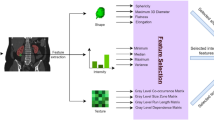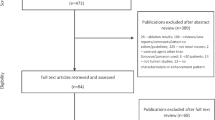Abstract
Purpose
The aim of this study was to assess the effect of denoising on objective heterogeneity scores and its diagnostic capability for the diagnosis of angiomyolipoma (AML) and renal cell carcinoma (RCC).
Materials and Methods
A total of 158 resected renal masses ≤4 cm [98 clear cell (cc) RCCs, 36 papillary (pap)-RCCs, and 24 AMLs] from 139 patients were evaluated. A representative contrast-enhanced computed tomography (CT) image for each mass was selected by a genitourinary radiologist. A largest possible region of interest was drawn on each mass by the radiologist, from which three objective heterogeneity indices were calculated: standard deviation (SD), entropy (Ent), and uniformity (Uni). Objective heterogeneity indices were also calculated after images were processed with a denoising algorithm (non-local means) at three strengths: weak, medium, and strong. Two genitourinary radiologists also subjectively scored each mass independently using a three-point scale (1–3; with 1 the least and 3 the most heterogeneous), which were added to represent the final subjective heterogeneity score of each mass. Heterogeneity scores were compared among mass types, and area under the ROC curve (AUC) was calculated.
Results
For all heterogeneity indices, cc-RCC was significantly more heterogeneous than pap-RCC and AML (p < 0.001), but no significant difference was found between pap-RCC and AML (p > 0.01). For cc-RCC and pap-RCC differentiation, AUCs were 0.91, 0.81, 0.78, and 0.78 for the subjective score, SD, Ent, and Uni, respectively, using original images. The corresponding AUC values were 0.84, 0.74, 0.79, and 0.80 for differentiation of AML and cc-RCC. Noise reduction at weak setting improves AUC values by 0.03, 0.05, and 0.05 for SD, entropy, and uniformity for differentiation of cc-RCC from pap-RCC. Further increase of filtering strength did not improve AUC values. For differentiation of AML vs. cc-RCC, the AUC values stayed relatively flat using the noise reduction technique at different strengths for all three indices.
Conclusions
Both subjective and objective heterogeneity indices can differentiate cc-RCC from pap-RCC and AML. Noise reduction improved differentiation of cc-RCC from pap-RCC, but not differentiation of AML from cc-RCC.





Similar content being viewed by others
References
Silverman SG, Israel GM, Herts BR, Richie JP (2008) Management of the incidental renal mass. Radiology 249(1):16–31
Jinzaki M, Tanimoto A, Narimatsu Y, et al. (1997) Angiomyolipoma: imaging findings in lesions with minimal fat. Radiology 205(2):497–502
Kim JK, Park SY, Shon JH, Cho KS (2004) Angiomyolipoma with minimal fat: differentiation from renal cell carcinoma at biphasic helical CT. Radiology 230(3):677–684
Yang CW, Shen SH, Chang YH, et al. (2013) Are there useful CT features to differentiate renal cell carcinoma from lipid-poor renal angiomyolipoma? AJR Am J Roentgenol 201(5):1017–1028
Takahashi N, Leng S, Kitajima K, et al. (2015) Small (<4cm) renal masses: differentiation of angiomyolipoma without visible fat from renal cell carcinoma using unenhanced and contrast-enhanced CT. AJR Am J Roentgenol 205(6):1194–1202
Sasaguri K, Takahashi N, Gomez-Cardona D, et al. (2015) Small (<4 cm) renal mass: differentiation of oncocytoma from renal cell carcinoma on biphasic contrast-enhanced CT. AJR Am J Roentgenol 205(5):999–1007
Lubner MG, Stabo N, Abel EJ, Del Rio AM, Pickhardt PJ (2016) CT textural analysis of large primary renal cell carcinomas: pretreatment tumor heterogeneity correlates with histologic findings and clinical outcomes. AJR Am J Roentgenol: W1–W10.
Lubner MG, Stabo N, Lubner SJ, et al. (2015) CT textural analysis of hepatic metastatic colorectal cancer: pre-treatment tumor heterogeneity correlates with pathology and clinical outcomes. Abdom Imaging 40(7):2331–2337
Mattonen SA, Palma DA, Haasbeek CJ, Senan S, Ward AD (2014) Early prediction of tumor recurrence based on CT texture changes after stereotactic ablative radiotherapy (SABR) for lung cancer. Med Phys 41(3):033502
Mattonen SA, Tetar S, Palma DA, et al. (2015) Imaging texture analysis for automated prediction of lung cancer recurrence after stereotactic radiotherapy. J Med Imaging (Bellingham) 2(4):041010
Miles KA, Ganeshan B, Griffiths MR, Young RC, Chatwin CR (2009) Colorectal cancer: texture analysis of portal phase hepatic CT images as a potential marker of survival. Radiology 250(2):444–452
Ng F, Kozarski R, Ganeshan B, Goh V (2013) Assessment of tumor heterogeneity by CT texture analysis: can the largest cross-sectional area be used as an alternative to whole tumor analysis? Eur J Radiol 82(2):342–348
Raman SP, Chen Y, Schroeder JL, Huang P, Fishman EK (2014) CT texture analysis of renal masses: pilot study using random forest classification for prediction of pathology. Acad Radiol 21(12):1587–1596
Raman SP, Schroeder JL, Huang P, et al. (2015) Preliminary data using computed tomography texture analysis for the classification of hypervascular liver lesions: generation of a predictive model on the basis of quantitative spatial frequency measurements—a work in progress. J Comput Assist Tomogr 39(3):383–395
Manduca A, Yu L, Trzasko JD, et al. (2009) Projection space denoising with bilateral filtering and CT noise modeling for dose reduction in CT. Med Phys 36(11):4911–4919
La Rivière PJ (2005) Penalized-likelihood sinogram smoothing for low-dose CT. Med Phys 32:1676
Buades A, Coll B, Morel JM (2005) A review of image denoising algorithms, with a new one. Multiscale Model Sim 4(2):490–530
Li Z, Yu L, Trzasko JD, et al. (2014) Adaptive nonlocal means filtering based on local noise level for CT denoising. Med Phys 41(1):011908
Thibault JB, Sauer KD, Bouman CA, Hsieh J (2007) A three-dimensional statistical approach to improved image quality for multislice helical CT. Med Phys 34(11):4526–4544
McCollough CH, Chen GH, Kalender W, et al. (2012) Achieving routine submillisievert CT scanning: report from the summit on management of radiation dose in CT. Radiology 264(2):567–580
Goh V, Ganeshan B, Nathan P, et al. (2011) Assessment of response to tyrosine kinase inhibitors in metastatic renal cell cancer: CT texture as a predictive biomarker. Radiology 261(1):165–171
Metz CE, Pan X (1999) “Proper” binormal ROC curves: theory and maximum-likelihood estimation. J Math Psychol 43(1):1–33
Author information
Authors and Affiliations
Corresponding author
Ethics declarations
Funding
No funding was received for this study.
Conflict of interest
Dr. McCollough receives industry funding from Siemens Healthcare, unrelated to this work. The other authors declare that they have no conflict of interest.
Ethical approval
All procedures performed in studies involving human participants were in accordance with the ethical standards of the institutional and/or national research committee and with the 1964 Helsinki declaration and its later amendments or comparable ethical standards.
Informed consent
Informed consent was obtained from all individual participants included in the study.
Rights and permissions
About this article
Cite this article
Leng, S., Takahashi, N., Gomez Cardona, D. et al. Subjective and objective heterogeneity scores for differentiating small renal masses using contrast-enhanced CT. Abdom Radiol 42, 1485–1492 (2017). https://doi.org/10.1007/s00261-016-1014-2
Published:
Issue Date:
DOI: https://doi.org/10.1007/s00261-016-1014-2




